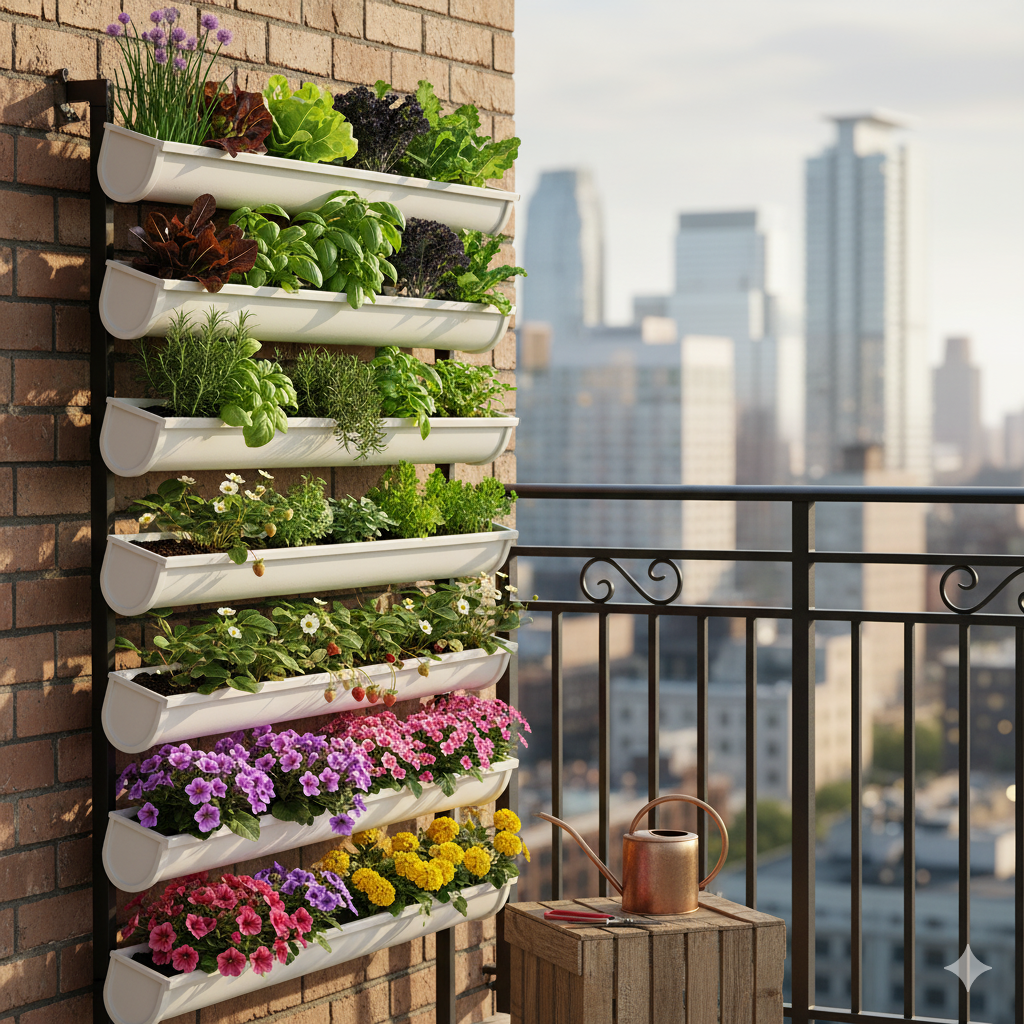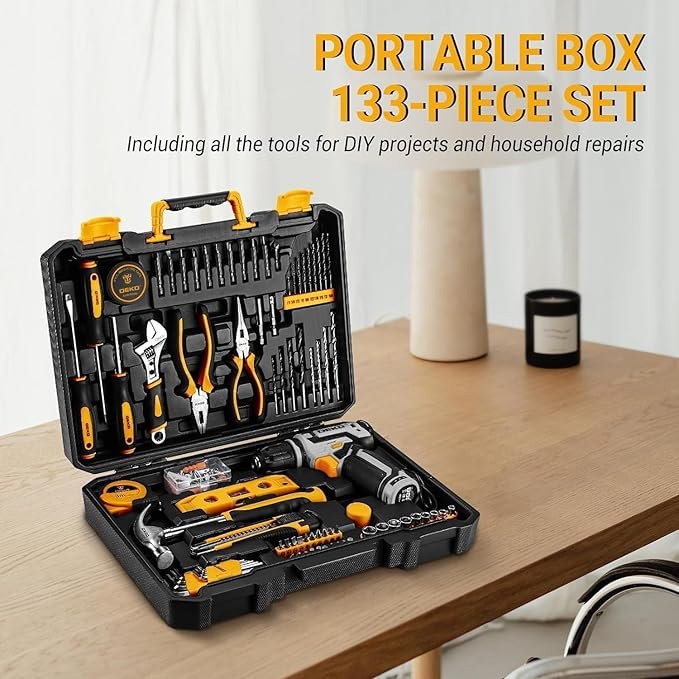Look out at your balcony. What do you see? For many city dwellers, it’s a sliver of concrete, a forgotten space, a repository for a lonely chair or a dormant bicycle. It’s a reminder of the nature we crave but can’t quite reach. But what if that small space wasn’t a limitation? What if it was an invitation?
Imagine stepping out onto that same balcony, but now it’s a cascade of green. The air smells of fresh mint and damp earth. You snip a few leaves of crisp lettuce for your lunch, right outside your door. This isn’t a far-off dream. This is the reality you can create with a balcony gutter garden—an ingenious, space-saving, and deeply rewarding way to reclaim a piece of the wild in the heart of the city.
This guide is your roadmap. We’re not just showing you how to hang a few planters; we’re showing you how to cultivate a personal sanctuary. This is your chance to unplug from the digital chaos, get your hands dirty, and connect with the simple, profound rhythm of a growing season. It’s the perfect unplugged routine, and it starts right on your balcony.

Table of Contents
What is a Balcony Gutter Garden and Why is it a Game-Changer?
At its core, a balcony gutter garden is brilliantly simple: it’s the practice of using new or repurposed rain gutters as horizontal planters. By mounting them on walls, railings, or hanging them in tiers, you can create multiple layers of growing space where there was once only air.
But its simplicity belies its power. For the urban gardener, this method is a true game-changer.
- Ultimate Space Efficiency: Gutters are long and narrow, designed to fit into tight spaces. This makes them the perfect solution for small, narrow balconies, allowing you to grow a surprising amount of food and flowers without sacrificing your precious floor space. It’s vertical gardening at its most accessible.
- Budget-Friendly & Sustainable: A brand new 10-foot section of vinyl gutter can cost less than a single large decorative pot. Better yet, you can often find off-cuts or used gutters for free from construction sites (with permission!) or home renovation projects, giving them a second life.
- Superior Drainage Control: One of the biggest challenges in container gardening is waterlogged soil, which leads to root rot. The shallow depth and long run of a gutter, combined with drainage holes you’ll add, make it almost impossible to overwater your plants.
- Accessibility for Everyone: For renters, gutter gardens can often be installed non-permanently on railings. For those with mobility challenges, they can be mounted at the perfect waist height, eliminating the need for bending and kneeling.
- A Living Wall of Art: Don’t just think of them as planters. Think of them as a canvas. You can paint them to match your decor, arrange them in creative patterns, and plant trailing flowers to create a stunning, cascading wall of green that will be the envy of your neighbors.
Planning Your Urban Oasis: 3 Crucial Steps Before You Start
Enthusiasm is wonderful, but a little planning goes a long way to ensuring your balcony gutter garden thrives. Take a few moments to assess your unique space.
1. Analyze Your Sunlight
This is the most critical factor in your garden’s success. Most edible plants need at least 6 hours of direct sunlight per day to flourish.
- Track the Sun: Spend a day observing your balcony. Use a compass app to determine its orientation (south-facing is the sunniest, north-facing the shadiest). Note what time the sun first hits the space and what time it leaves.
- Be Honest: If you only get 3-4 hours of morning sun, you won’t be able to grow tomatoes, but you can have a fantastic crop of lettuce, spinach, and mint. Matching plants to your light conditions is the key.
2. Consider Weight and Regulations
While gutter gardens are relatively lightweight, it’s always wise to be safe.
- Check the Rules: If you rent or live in a building with an HOA, take a quick look at your agreement. Most have rules about attaching items to railings or exterior walls. A non-permanent installation using zip ties or clamps is often the best approach.
- Estimate the Weight: A 10-foot vinyl gutter filled with damp, lightweight potting mix and plants might weigh 25-40 pounds. Ensure the structure you’re attaching it to (railing, wall) is sound.
3. Choose Your Gutters
You have a few options when it comes to the main component of your garden.
- Material:
- Vinyl (PVC): This is the most popular choice. It’s lightweight, inexpensive, easy to cut, and won’t rust. It comes in a standard white, but can be painted with a plastic-safe spray paint.
- Aluminum/Steel: More durable and rigid than vinyl, but also heavier and more expensive. Can be a great aesthetic choice.
- Style:
- K-Style: This style has a flat bottom and a decorative profile on the front. The flat bottom provides slightly more stability and soil volume, making it a top choice for gardening.
- Half-Round: This traditional semi-circle shape also works perfectly well and offers a classic look.
- Safety Note on Repurposed Gutters: If you find old, painted metal gutters, be aware of the small possibility of lead-based paint. If you’re unsure, it’s safest to use them for ornamental plants only, not edibles.
Step-by-Step: How to Build Your Balcony Gutter Garden
This is where the fun begins! With your planning done, it’s time to get your hands dirty.
Step 1: Gather Your Materials & Tools
- Gutters: In your chosen material and style.
- Gutter End Caps: You’ll need a pair for each gutter section.
- Silicone Sealant: A tube of waterproof, outdoor-rated sealant to secure the end caps.
Drill withDrill Bits: You’ll need a small bit (1/4 inch) for drainage holes and a larger bit if your mounting hardware requires it.- Measuring Tape & Marker
- Hacksaw: For cutting the gutters to size.
- Level: To ensure your installation is perfectly horizontal.
- Mounting Brackets & Hardware: Gutter brackets, heavy-duty zip ties, screws, or hooks depending on your chosen mounting method.
- Lightweight Potting Mix: Do NOT use heavy garden soil!
- Your Plants or Seeds!

Step 2: Prepare the Gutters
- Measure and Cut: Measure your space and decide on the length of your gutters. Mark a clear line and use a hacksaw to make a straight, clean cut. Smooth any rough edges with sandpaper.
- Drill Drainage Holes: This is the most important step for plant health! Flip the gutter upside down. Using a 1/4-inch drill bit, drill drainage holes every 6 to 8 inches along the entire length of the gutter’s bottom.
- Attach End Caps: Apply a generous bead of silicone sealant to the inside rim of an end cap. Firmly press it onto one end of the gutter. Repeat on the other side. Let the sealant cure for the time specified on the tube (usually several hours).
Step 3: Mount Your Gutter Garden
Choose the method that works best for your balcony.
- For Railing-Mounted (Renter-Friendly):
- Purchase U-bolts or specialized deck rail brackets that fit your railing’s dimensions.
- Alternatively, simply place the gutter directly on top of a flat railing.
- Secure the gutter by threading heavy-duty, UV-resistant zip ties through your drainage holes and around the railing. Cinch them tightly so there is absolutely no wobble. This method is surprisingly sturdy and completely non-damaging.
- For Wall-Mounted:
- Mark a level line on the wall where you want the gutter to hang.
- Use the level to ensure your line is perfectly straight.
- Install standard gutter mounting brackets along the line according to the manufacturer’s instructions, typically one every 24-32 inches.
- Snap your prepared gutter firmly into the brackets.
Step 4: Fill ‘Er Up!
- Choose the Right Soil: The weight of your garden and the health of your plants depend on this. Buy a quality, lightweight potting mix. Look for bags that contain ingredients like peat moss, coir, perlite, and vermiculite. Avoid anything labeled “garden soil” or “topsoil” as it will be too dense and heavy.
- Fill the Gutters: Add your potting mix to the gutters, filling them to about an inch from the top. Don’t compact it down.
Plant Power: What to Grow in Your Balcony Gutter Garden
The shallow depth of gutters makes them ideal for plants with smaller, fibrous root systems. Think “out,” not “down.”
Best Edibles for Gutter Gardens:
- Lettuces & Leafy Greens: This is what gutters were made for! Loose-leaf lettuce, spinach, arugula, and kale are perfect. Use the “cut-and-come-again” method for a continuous harvest.
- Herbs: A complete kitchen herb garden is at your fingertips. Mint, chives, thyme, oregano, parsley, and cilantro all thrive. Basil works too but requires more consistent watering.
- Shallow Root Vegetables: Radishes are a fantastic, fast-growing option. You can also grow small, round carrot varieties.
- Strawberries: Alpine or everbearing strawberries will happily produce fruit all season long, cascading over the side of the gutter.
Best Ornamental Flowers:
- Trailing Flowers: Create a waterfall of color with plants like sweet alyssum, lobelia, trailing petunias, and creeping Jenny.
- Upright Annuals: Marigolds (great for pest control!), pansies, and zinnias add pops of vibrant color.
- Succulents: For hot, sun-baked balconies, a gutter filled with a variety of succulents like Echeveria and Sedum can create a stunning, low-water display.
| Plant Type | Sunlight Needs | Watering Needs | Notes |
| Lettuce/Spinach | 4-6 hours | High | Perfect for “cut-and-come-again”. |
| Herbs (Mint, Thyme) | 6+ hours | Moderate | Mint can be invasive; the gutter contains it perfectly. |
| Radishes | 6+ hours | Moderate | Harvest quickly, in as little as 30 days. |
| Strawberries | 6-8 hours | High | Choose an everbearing variety for a long season. |
| Marigolds | 6+ hours | Low-Moderate | Helps deter pests from your edible plants. |
| Succulents | 6+ hours | Very Low | Use a cactus/succulent potting mix. |
Tending Your Sanctuary: Care and Maintenance Tips
Your garden is built! Now comes the gentle, mindful ritual of caring for it.
- Watering is a Daily Ritual: This is the #1 rule of gutter gardening. The shallow soil depth means they dry out fast, especially on hot, windy days. Make a habit of checking the soil with your finger every morning. If the top inch is dry, it’s time to water thoroughly until it runs from the drainage holes.
- Feed Your Plants: The limited soil volume also means nutrients get used up quickly. Feed your plants every 2-3 weeks during the growing season with a balanced, all-purpose liquid fertilizer diluted to half-strength.
- Harvest Often: The more you harvest herbs and leafy greens, the more they will grow. Regular trimming encourages bushier, healthier plants and provides you with a steady supply of fresh ingredients.
Your Unplugged Routine Awaits
You’ve done it. You’ve transformed a piece of overlooked urban space into a living, breathing source of beauty and nourishment. Your balcony gutter garden is more than a project; it’s a practice. It’s a daily reason to step outside, to notice the subtle changes of a new leaf unfurling, to feel the sun on your face, and to taste the incredible flavor of something you grew with your own hands. This is the antidote to the digital drain. This is your small sanctuary in the city.
Now it’s your turn. Are you ready to create your own green oasis?
We would be thrilled to see your journey unfold. Share photos of your balcony gutter garden—from the first drill hole to the first harvest—on social media with the hashtag #UnpluggedRoutineGarden. Ask questions, share your successes, and inspire others in the comments below. Let’s prove that no space is too small to grow a little peace.